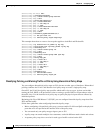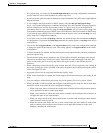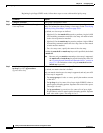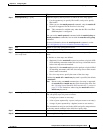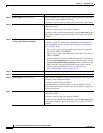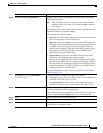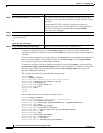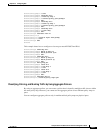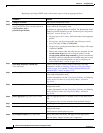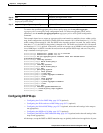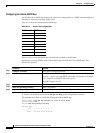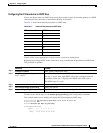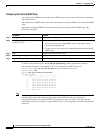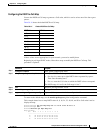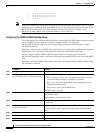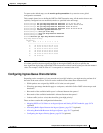
39-68
Catalyst 3750-X and 3560-X Switch Software Configuration Guide
OL-21521-01
Chapter 39 Configuring QoS
Configuring Standard QoS
Beginning in privileged EXEC mode, follow these steps to create an aggregate policer:
Command Purpose
Step 1
configure terminal Enter global configuration mode.
Step 2
mls qos aggregate-policer
aggregate-policer-name rate-bps burst-byte
exceed-action {drop |
policed-dscp-transmit}
Define the policer parameters that can be ap
plied to multiple traffic
classes within the same policy map.
By default, no aggregate policer is defined. For information on the
n
umber of policers supported, see the “Standard QoS Configuration
Guidelines” section on page 39-36.
• For aggregate-policer-name, specify the name of the aggregate
policer.
• For rate-bps, specify average traffic rate in bits per second
(b/s). The range is 8000 to 1000000000.
• For burst-byte, specify the normal burst size in bytes. The range
is 8000 to 1000000.
• Specify the action to take when the rates are exceeded. Use the
exceed-action drop keywords to drop the packet. Use the
exceed-action policed-dscp-transmit keywords to mark down
the DSCP value (by using the policed-DSCP map) and to send
the packet. For more information, see the “Configuring the
Policed-DSCP Map” section on page 39-72.
Step 3
class-map [match-all | match-any]
class-map-name
Create a class map to classify traffic as necessary. For more
information, see the “Classifying Traffic by Using Class Maps”
section on page 39-51 and the “Creating Named Standard and
Extended ACLs” section on page 37-15.
Step 4
policy-map policy-map-name Create a policy map by entering the policy map name, and enter
policy-map configuration mode.
For more information, see the “Classify
ing, Policing, and Marking
Traffic on Physical Ports by Using Policy Maps” section on
page 39-56.
Step 5
class class-map-name Define a traffic classification, and enter policy-map class
configuration mode.
For more information, see the “Classify
ing, Policing, and Marking
Traffic on Physical Ports by Using Policy Maps” section on
page 39-56.
Step 6
police aggregate aggregate-policer-name Apply an aggregate policer to multiple classes in the same policy
map.
For a
ggregate-policer-name, enter the name specified in Step 2.
Step 7
exit Return to global configuration mode.
Step 8
interface interface-id Specify the port to attach to the policy map, and enter interface
configuration mode.
Valid interfaces include physical ports.
Step 9
service-policy input policy-map-name Specify the policy-map name, and apply it to an ingress port.
Only one policy map per ingress port is supported.



